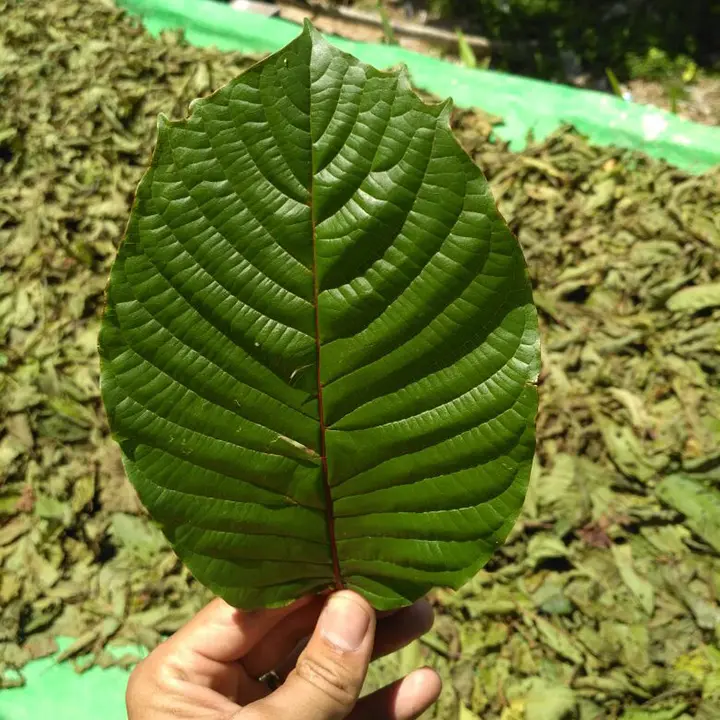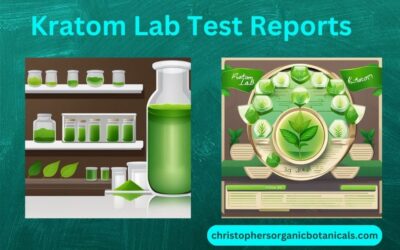What Happens to Kratom Alkaloids Over Periods Of Time?
I wanted to share something with everyone that I thought was interesting about kratom alkaloids. We retested some batches recently to check if kratom alkaloids degrade during storage or after 1-2 years. I will be using Green Riau Kratom Powder as an example for this blog post.
Freezing Kratom Alkaloids
Years ago, I made a bad choice by freezing kratom to keep it fresh for longer. Naively, I believed that subjecting it to cold temperatures would somehow extend its shelf life. However, instead of achieving the desired outcome, this misguided action led to the formation of condensation on the kratom.
In my misguided belief, I failed to consider the impact of freezing temperatures on the kratom’s delicate composition. When kratom got cold, water inside it condensed and formed small droplets on its surface. This condensation not only altered the physical appearance of the speciosa but also had adverse effects on its overall quality.
The presence of moisture caused by the condensation had detrimental consequences for the kratom. The excess water introduced a new element into the equation, creating an environment conducive to the growth of bacteria and mold. These microorganisms thrive in damp conditions, and their presence can significantly compromise the integrity and safety of the powder.
Furthermore, the condensation caused the powder to clump together, making it difficult to measure and consume accurately. The texture changed from loose and powdery to sticky and compact, making it difficult to separate and use in desired amounts. This clumping also affected the powder’s ability to dissolve properly, diminishing its effectiveness when consumed.
In addition to the physical changes, the freezing process also had an impact on the kratom’s potency. The extreme cold temperatures altered the chemical composition of the kratom, potentially degrading its active compounds. The frozen kratom might have lost its desired effects, making it less strong and less effective in giving the desired benefits.
Reflecting on this mistake, I now understand that freezing mitragyna Speciosa is not a suitable method for preserving its freshness. Instead, it is crucial to store kratom in a cool, dry place away from direct sunlight and moisture. By storing kratom correctly, you can keep it fresh and strong for longer. This means you’ll have a better time and get more benefits when you use it.
The problem with freezing it is when you defrost the kratom you will have issues with condensation and moisture. It was a mess, so I just started keeping my kratom in then original bag in the cabinet. Our packaging serves longer term storage purposes and not just transportation.
The bottom line is do not freeze kratom.
Kratom Alkaloids and Storage
Proper kratom storage is essential to maintain its potency, freshness, shelf life, and overall quality over time. Kratom, like other plant-based products, can degrade when exposed to certain environmental factors.
Here are some tips for storing kratom effectively:
- Keep it in an airtight container: Oxygen can lead to oxidation, which may cause the degradation of kratom alkaloids. Store kratom in a tightly sealed, airtight container to minimize exposure to air.
- Avoid exposure to sunlight: Sunlight and UV rays can break down the alkaloids in kratom and reduce its potency. Keep kratom in a dark and cool place to protect it from direct sunlight.
- Store in a cool and dry place: Heat and moisture can also contribute to kratom’s deterioration. Store in a cool, dry place like a cupboard or drawer, away from heat and moisture sources like stoves or sinks.
- Choose the right container material: Opt for containers made of glass or food-grade plastic that won’t interact with the kratom or leach harmful chemicals into it.
- Label the container: If you have multiple strains or batches of kratom, label each container to identify the type and date of purchase. This way, you can keep track of freshness and potency.
- Keep away from strong odors: Kratom can absorb odors from its surroundings, which may affect its taste and aroma. Avoid storing it near strong-smelling substances.
- Do not freeze kratom: Freezing kratom is not recommended, as it can cause condensation inside the container when thawing, potentially introducing moisture.
- Rotate stock: If you buy kratom in bulk, consider dividing it into smaller quantities and storing only a portion of it for regular use. This way, you can minimize the exposure of the rest of the kratom to air and light until it’s needed.
Follow these guidelines to keep your kratom fresh, strong, and enjoyable for a long time. Always purchase kratom from reputable vendors to ensure you receive high-quality and uncontaminated products.
Use a Mason Jar and desiccant packs to store kratom powder for longer periods if you need to. I have done this and stored it for 3 years.
The mason jar and the kratom in my cabinet were equally effective during the test period.
Kratom Alkaloid Differences Over Time
We did not see anything in the way of major bacterial growth over 1-2 year’s period. Some bacteria will grow naturally, and we wanted to also see the differences in bacteria growth in proper holding conditions. We also noticed that the lower alkaloids were a bit higher than the earlier testing result.
I originally thought that this was because of a variable that we find in the same batch of kratom. The alkaloids are never the exact same and vary 0.01%.
I saw that the differences were bigger than a small percentage. The lower alkaloids were slightly higher, but the Mitragynine didn’t change much. 7-Hydroxymitragynine remained unchanged in all seven samples, while lower alkaloids showed increased levels in all tested samples.
Is 7-Hydroxymitragynine even an Alkaloid of kratom?
The 7-hydroxymitragynine alkaloid is a metabolite of kratom and is not found in commercial kratom products. 7-hydroxymitragynine, or 7-ohmz is believed to be more potent than mitragynine, another significant compound found in kratom. Additionally, it does not significantly impact the plant’s medicinal properties.
Additionally, 7-hydroxymitragynine is thought to be responsible for some of the sedative effects of certain kratom strains, but recent science shows that 7-hydroxymitragynine is not found in the leaf itself.
This could be from the natural variable found in the plant. Interestingly the 7-hydroxymitragynine did not get any higher. These results were similar with the seven batches that We assessed for this experiment.
Some people believe that 7-hydroxymitragynine becomes stronger over time. However, our observation showed that Mitragynine, Speciogynine, and Paynantheine experienced a slight increase, while 7-hydroxymitragynine remained unchanged.
We are also working with a plant that has some variables, so that may also come into play. Unopened packages do not show signs of degradation with long term storage.
Kratom Science is something that We are continuing to learn about daily. We want to explain the science of kratom to you so we can learn together about the amazing plant we all love.
Kratom Alkaloid Percentage
I was getting some questions about the percentages that we have on our packaging. We add these percentages to ensure the buyer that they are buying pure products.
We list some of the kratom alkaloids on the package to help identify the difference between each batch. These percentages vary and can make a difference in the way it feels.
I do not make up strain names. We use the names traditionally given by the Indonesian kratom Farmers.
Testing for alkaloids is important to distinguish batches and gain insight into how they work. Alkaloids are natural compounds found in plants and organisms. They have many uses in medicine, agriculture, and pharmacology due to their diverse biological activities.
By conducting tests for alkaloids, researchers and scientists can determine the presence and concentration of these compounds in different batches. This information is essential for quality control purposes, as it ensures that products containing alkaloids meet the required standards. Moreover, it helps in identifying any potential variations or inconsistencies between batches, which can be crucial in industries such as pharmaceuticals, where precise dosages and compositions are vital.
Furthermore, testing for alkaloids provides valuable insights into the specific properties and effects of different alkaloids. Each alkaloid has its own unique chemical structure and biological activity, which can vary significantly from one compound to another. By analyzing the alkaloid content in a sample, researchers can gain a better understanding of its potential uses and effects.
In addition, testing for alkaloids can also aid in the discovery of new compounds with therapeutic potential. By systematically testing different plant extracts or natural sources for alkaloids, researchers can identify novel compounds that may have promising applications in drug development.
Overall, testing for alkaloids plays a crucial role in differentiating batches and understanding the diverse properties and effects of these compounds. It ensures quality control, provides valuable insights into their potential uses, and contributes to the discovery of new therapeutic compounds.
We also learn how alkaloid differences can affect us differently. I wanted to share this with you to better understand how speciosa behaves when stored for long times. I also wanted to explain that kratom has slight differences in the same batch.
Kratom is a natural plant and does vary slightly from leaf to leaf. It takes approximatelyone full grown kratom tree will produce 20 kgs of kratom powder. A Mitragyna speciosa tree grows to a height of over one hundred feet at times.
We can just imagine how many kratom leaves are in a 20 kg package. I love kratom! Kratom changed my life a lot. I’m glad I can still share what I love with all of you. My story is much better now that I have found kratom.
Kratom research
We are extremely honored and delighted to announce our unwavering support and commitment to the University of Florida’s esteemed College of Pharmacy for their groundbreaking research on Kratom. We strongly support the use of Kratom.
Kratom is a plant from Southeast Asia. It has potential therapeutic benefits. We believe it should be used in scientific research and development.
The University of Florida’s College of Pharmacy has long been recognized as a leading institution in pharmaceutical research and education. Their exceptional faculty, state-of-the-art facilities, and cutting-edge resources make them the ideal partner for this crucial research endeavor. By collaborating with such a prestigious institution, we are confident that we can contribute significantly to the growing body of knowledge surrounding Kratom and its potential impact on human health.
Kratom, also known as Mitragyna speciosa, has gained considerable attention in recent years due to its purported medicinal properties. While it has been traditionally used for centuries in Southeast Asia for its stimulant and analgesic effects, its potential therapeutic applications have only begun to be explored in Western medicine. By supporting the University of Florida’s research efforts, we aim to shed light on the pharmacological properties of Kratom and its potential as a natural alternative for pain management, mood enhancement, and even addiction treatment.
The research conducted at the University of Florida’s College of Pharmacy will encompass a comprehensive analysis of Kratom’s chemical composition, its interaction with various receptors in the body, and its potential effects on different physiological systems. Through rigorous experimentation and meticulous data analysis, the researchers will strive to uncover the mechanisms of action behind Kratom’s reported benefits and determine its safety and efficacy for human use.
Furthermore, this collaboration will not only contribute to the scientific community’s understanding of Kratom but also help dispel any misconceptions or misinformation surrounding its use. By conducting rigorous and evidence-based research, we aim to provide healthcare professionals, policymakers, and the general public with accurate and reliable information about Kratom, enabling them to make informed decisions regarding its potential benefits and risks.
In conclusion, our partnership with the University of Florida’s College of Pharmacy for Kratom research represents a significant step forward in advancing our knowledge of this natural plant and its potential therapeutic applications.
We are proud to support the dedicated researchers and scientists at the University of Florida as they work tirelessly to unravel the mysteries of Kratom and its potential impact on human health. Together, we hope to pave the way for a better understanding and utilization of Kratom in the field of medicine, ultimately improving the lives of countless individuals worldwide.
Conclusion
Christopher McCurdy has done extensive work with mitragyna speciosa and We are proud to be supporting this endeavor.
The American Kratom Association is working to keep kratom legal and ensure the truth is being shared.
We have also been learning about chemotypes and phenotypes of kratom and how they are different from each other.
Stay tuned as we learn more about it and the way this plant works!
God Bless and Be Safe,
Christopher






Just wanted to say that although I’m late to comment on this post I appreciate the fact that you and your team actually continue to do research as well as being great advocates for kratom. I haven’t bought from you guys in a little while because temporary hard times, but I just wanted to re-iterate that you guys are awesome and my fav kratom one stop shop! I’m glad you brought in the crushed leaves option as well because I have never consumed it like that and eventually will try. Thanks and God bless!